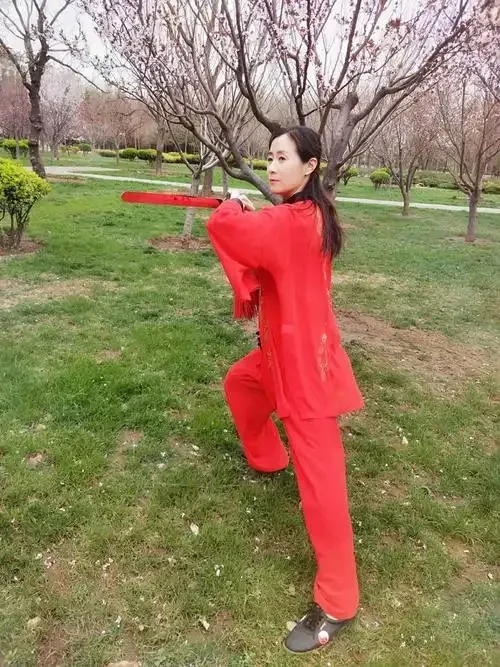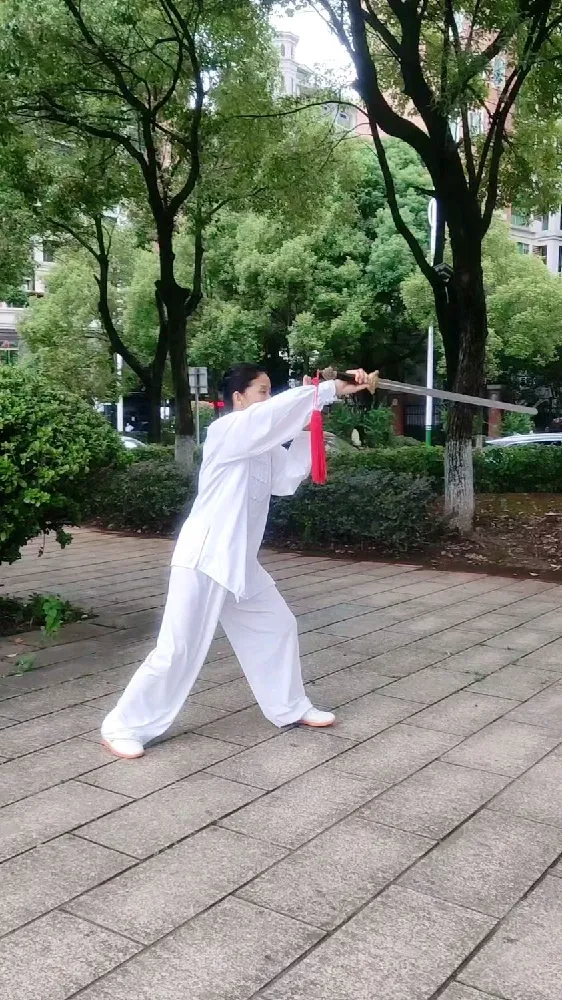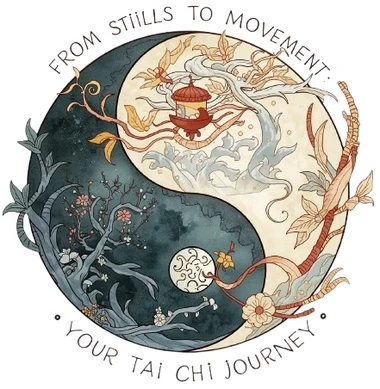Think Tai Chi is all about slow, empty-handed movements? Let's talk about the sword. Tai Chi Jian (太极剑) is where the gentle flow of Tai Chi meets the elegant power of a classical Chinese sword.
It’s not about brute force; it’s about balance, precision, and a moving meditation that sharpens your mind and body.
It’s a low-impact, full-body workout that can boost your balance better than standard Tai Chi, reduce stress, and connect you to a profound martial art. Ready to see how a sword can change your fitness routine?
Here’s the real kicker: research suggests its slow, coordinated movements can improve balance ability by 13.6% more than regular Tai Chi practice.
So, if you're worried about stability as you age, this might be your answer.

What is Tai Chi Jian, Anyway?
You’ve seen the slow, graceful movements of Tai Chi. Now, imagine that same flow, but with a sword in hand. That’s Tai Chi Jian.
It’s not a violent martial art. In fact, it’s the opposite. It’s a practice that combines the internal principles of Tai Chi—like using your mind to direct energy (Qi) and moving from your core—with the precise, artistic techniques of traditional Chinese swordsmanship.
Think of it like this: If Tai Chi is learning to write beautiful calligraphy with a brush, Tai Chi Jian is learning to do it with a finely sharpened, weighted sword.
The fundamental principles are the same, but the tool demands a new level of focus, coordination, and grace.
So, What's the Big Deal? Why Pick Up a Sword?
Good question. Why not just stick to bare-handed Tai Chi? The sword acts as an amplifier.
- It extends your body. The sword becomes part of your arm, making flaws in your posture or movement instantly obvious. It forces you to be more precise.
- It intensifies your focus. You can’t let your mind wander when you’re directing a pointy piece of metal. This deepens the meditative, stress-busting benefits.
- It’s a full-body coordinator. Your feet, hips, waist, hands, and eyes all have to work in perfect harmony to make the sword move correctly. It’s the ultimate test of mind-body connection.
"The sword is called the 'gentleman of weapons' in China. Practicing with it isn't just about fighting; it's about cultivating character, patience, and precision."

What Are the Real, No-BS Benefits of Tai Chi Sword?
Forget vague promises of "inner peace." Let's talk about tangible benefits you can actually feel.
Will It Actually Make Me Healthier?
Yes, and here’s how. This isn't just spiritual fluff; it's grounded in physical and mental science.
- Better Balance & Coordination: Remember that 13.6% stat? The continuous, controlled weight shifts and one-legged stances rewire your brain and strengthen the stabilizing muscles you use every day. Say goodbye to that wobbly feeling on uneven ground.
- A Calmer, Stronger Heart: The slow, deep breathing regulates your nervous system. Studies link it to improved Heart Rate Variability (HRV), a key marker of your body's ability to handle stress. You’re literally training your heart to stay calm under pressure.
- Joint-Friendly Strength & Flexibility: This isn’t high-impact exercise. It builds functional strength in your legs and core while gently taking your joints through their full range of motion. It’s physical therapy you actually enjoy.
What's In It for My Brain?
This is where Tai Chi Jian truly shines. It’s often called “moving meditation.”
- You Can’t Zone Out: Trying to correctly execute a "Circle Sword" or "Parry" while maintaining a perfect stance requires 100% of your attention. This single-pointed focus is a powerful antidote to a racing, anxious mind.
- It Builds "Body Smarts": In fitness terms, this is your proprioception—your brain's sense of where your body is in space. The better it gets, the more graceful and less clumsy you become in daily life.
In a nutshell: You’ll stand firmer, move easier, and feel calmer. It’s a triple-threat wellness practice disguised as an ancient art form.
Tai Chi Sword Styles: Which One is Right for You?
Just like music has different genres, Tai Chi Jian has different styles. Don't get overwhelmed; think of it as having options.
- Yang Style: This is your go-to for starting out. It’s the most popular worldwide for a reason. The movements are big, slow, and graceful. If you want the classic, flowing Tai Chi look, this is it. The 32 Form is the universal beginner’s routine.
- Chen Style: Want something with more fire? Chen Style is the original. It incorporates spiraling power, explosive releases, and lower stances. It’s dynamic and martial.
- Wudang Style: This one feels mystical. Coming from the Taoist monks of Wudang Mountain, it’s known for its agility, swift changes, and a lighter, more "airy" feel. It often includes more jumping and advanced techniques.
My advice? Most people start with Yang Style (32 Form). It’s the standard for a reason—it lays a perfect foundation. You can always explore the others later.

How Do I Choose a Tai Chi Sword? (No, It's Not Just for Show)
Let's get this out of the way: that cheap, shiny "wall hanger" from the online marketplace? It's a waste of money and potentially unsafe. A real practice sword is a finely balanced tool, not a decoration.
Choosing your first Jian is like choosing a good pair of running shoes—it needs to fit you and your practice. Get it wrong, and you'll struggle. Get it right, and it feels like an extension of your own arm.
Here’s a straightforward checklist to test any sword, even as a beginner:
- ✔️The Balance Test (The #1 Rule): Place your index and middle finger on the blade, about an inch below the guard. A well-made sword will balance horizontally, not tip towards the blade or the hilt. This balance is what makes the movements feel fluid, not clumsy.
- ✔️ The Flexibility Test: Gently press the tip against the floor and bend it. It should have a smooth, 90-degree flex and spring back straight. Too stiff, and it jars your joints; too floppy, and it’s uncontrollable.
- ✔️ The Length Test: Hold the sword straight down, the tip should rest just above the ground. A common rule is that the tip should not be lower than your ear and not higher than your eyebrow when held upright next to your arm.
- ✔️ The Material: For most beginners, a stainless steel blade is perfect. It's low-maintenance and won't rust. Forget "battle-ready" carbon steel—that's for advanced practitioners who enjoy constant oiling and polishing.
A quick reality check: I made the mistake of buying a sword that was too heavy at first. It felt impressive, but my practice was sloppy and my wrist ached. Lighter and better-balanced made all the difference.
What Are the Basic Tai Chi Sword Moves I Should Know?
You don't need to learn 50 techniques on day one. Focus on mastering these core moves.
They are the alphabet that forms the entire language of Tai Chi Jian.
The Foundational Stances (Your Power Source)
Before you even swing the sword, your feet and body need to be right. The power comes from the ground up.
- Bow Stance (Gong Bu): Your front knee is bent (but not past your toe!), back leg straight. This is your "going forward" stance.
- Empty Stance (Xu Bu): About 90% of your weight is on your back leg. Your front foot just taps the ground for balance. This is your "ready to move" stance.
- Drop Stance (Pu Bu): One leg is deeply bent, the other is stretched out to the side. It's a low, powerful, stretching stance.
The Essential Sword Techniques (The Fun Part)
Now, let's add the sword. Each move has a specific purpose and "feel."
- Point Sword (Dian Jian): A sharp, crisp flick of the wrist to strike with the tip. Think of it like a snake striking—fast and precise.
- Thrust/Stab (Ci Jian): A direct, powerful extension from your core, driving the point forward. This is your classic "lunge and stab."
- Parry (Lan Jian): A soft, circular block that uses the opponent's energy against them. You're not clashing swords; you're guiding their attack away.
- Chop (Pi Jian): A committed, downward cutting motion, like an axe splitting wood. Power comes from the whole body, not just the arm.
- Slice/Sweep (Sao Jian): The blade moves horizontally, low to the ground, "sweeping" an opponent's legs.
Why does this matter? Knowing what you're doing transforms the practice from random waving to intentional, powerful movement.
You're not just moving; you're applying a technique.
How Can a Beginner Start Learning Tai Chi Sword?
Feeling inspired but wondering, "Can I actually do this?" Absolutely. Here’s your no-nonsense, step-by-step plan to get started without getting hurt or frustrated.
Step 1: Find a Teacher (This is Non-Negotiable)
You can learn a lot online, but not the foundational body mechanics. A good teacher will correct your posture in real-time, preventing bad habits that are hard to unlearn. Look for a school or instructor with good reviews that specifically mentions weapon forms.
Step 2: Master the Basics Without the Sword First
I know, it's tempting to grab the shiny object immediately. But trust me. Spend the first few weeks:
- Learning the fundamental stances (Bow, Empty, Drop).
- Practicing the footwork and weight transitions.
- Working on the "Sword Hand" (Jian Zhi) – the guiding hand that doesn't hold the sword.
Your future, more skilled self will thank you.
Step 3: Learn a Short, Standardized Form
Don't jump into a 50-move advanced form. The 32 Form Tai Chi Jian was created for people like you. It's the international standard for beginners and contains all the essential techniques in a logical, learnable sequence.
Step 4: Practice "Short and Sweet"
Marathon practice sessions lead to burnout. 15-20 minutes of focused, daily practice is far better than a sloppy 2-hour session once a week. Consistency is your secret weapon.
Step 5: Use Online Resources Wisely
Once you have a foundation from your teacher, use online videos (like those on YouTube) for review and different angles. But use them as a supplement, not a replacement.
What Are the Common Mistakes Every Beginner Makes?
Let's be real—we all mess up when we start. I sure did. Knowing these pitfalls ahead of time will save you months of frustration.
Check this list and be honest with yourself.
- ❌ The "Death Grip": You're nervous, so you clutch the sword handle like a lifeline. This tenses your entire arm, kills all fluidity, and makes your wrist as flexible as a brick.
* The Fix: Practice a "loose grip." Imagine you're holding a small bird—tight enough that it can't fly away, but loose enough that you don't crush it. - ❌ Staring at Your Sword: It's fascinating! But your eyes glued to the blade means your posture collapses and you lose all spatial awareness.
* The Fix: Your gaze should generally follow the direction of the movement or your guiding "sword fingers." Look where you're going, not at your feet. - ❌ Flailing Arms ("Chopstick Arms"): You're moving the sword with just your arm, disconnecting it from your body. The movement looks weak and disjointed.
* The Fix: This is the golden rule: Move your waist to move your sword. The power starts in your feet, is directed by your waist, and only then expressed through your arm and the sword. - ❌ Stiff Hips and Waist: You're so focused on your upper body that you become a statue from the waist down.
* The Fix: Consciously think about initiating every movement with a subtle turn of your hips. It feels weird at first, but it's the secret to true Tai Chi power.
A note on patience: I struggled with the "Death Grip" for weeks. My teacher kept telling me to relax, and I thought I was! It wasn't until I saw a video of myself that I saw how rigid I looked. Sometimes, you have to feel the mistake before you can correct it.
Beyond the Basics: What's the Deeper Purpose?
Once you get past the initial learning phase, you start to realize Tai Chi Jian isn't really about the sword at all. The sword is just the tool.
It's a Moving Meditation
You know that feeling when you're completely absorbed in a task, and all your daily worries just fade away? That's "flow state." Tai Chi Jian is a direct path to that.
- Your brain doesn't have room for stress when it's coordinating every part of your body to move a sword with precision.
- The rhythmic, flowing motion becomes a form of active mindfulness, calming your nervous system in a way that sitting still sometimes can't.
It Teaches You About Yielding and Adapting
This is the real martial arts wisdom. Many techniques aren't about meeting force with force. A "Parry" (Lan Jian) doesn't block an attack head-on; it accepts the energy and redirects it.
How this applies to you: It trains a mindset of adaptability. When life throws a problem at you, do you smash into it head-on, or do you find a smarter, more fluid way to navigate around it?
Okay, I'm Convinced. How Do I Fit This Into My Life?
You don't need to become a monk on a mountain. Here’s how to make it work in a busy, modern life.
- ✔️ Forget the "Perfect" Session: Can't do 30 minutes? Do 10. Can't do a full form? Practice just one movement—like the transition from Bow Stance to Empty Stance—with total focus. Consistent crumbs are better than a feast once a month.
- ✔️ Create Your "Corner of Calm": You don't need a huge space. Just enough room to take two steps in any direction and swing a sword without hitting a lamp. This becomes your dedicated mental and physical practice zone.
- ✔️ Practice "Off the Mat": The balance, posture, and calm you cultivate don't have to stay with the sword.
Notice your posture while waiting in line.
Practice deep, Tai Chi breathing when you're stuck in traffic.
Feel your root and stability when you pick up a heavy grocery bag.
- ✔️ Join a Community: Find a local group or an online forum. Sharing the journey with others provides motivation, support, and that little push to show up on days you don't feel like it.
Conclusion: Your Journey Starts with a Single Step (and a Single Movement)
The Tai Chi sword isn't a relic for ancient warriors. It's a living, breathing practice for anyone—at any age or fitness level—looking for a smarter way to move, a calmer mind, and a deeper connection to their own body.
It challenges you, rewards patience, and offers benefits that ripple into every part of your life. You don't have to be perfect. You just have to start.
So, what's your first step going to be? Finding a local class? Watching a video of the 32 Form? Whatever it is, take it. Your sword is waiting.
FAQ
What is a Tai Chi sword called?
It's called Tai Chi Jian (太极剑) - "Jian" being the specific term for the double-edged straight sword used in this practice. Unlike broader sabers, the Jian is known as the "gentleman of weapons" in Chinese culture.
What's the difference between Tai Chi and Tai Chi sword?
While both share core principles, Tai Chi sword adds extended coordination challenges. The weapon amplifies movements - flaws in posture become obvious, focus deepens, and you develop precise control through 360 degrees of motion. It's like the difference between dancing with your hands versus dancing with a flowing ribbon.
Is Tai Chi sword good for beginners?
Absolutely yes, if you start correctly. Beginners should: Learn basic stances without the sword first Begin with the standardized 32 Form Tai Chi Jian Choose a properly balanced practice sword Work with an instructor to avoid common mistakes like the "death grip"
Can Tai Chi sword be used for self-defense?
While modern practice focuses on health, the motions contain real martial applications. The parries, thrusts, and disorienting footwork teach timing, distance control, and using an opponent's energy against them - making it a sophisticated self-defense system when studied deeply.
What are the main Tai Chi sword styles?
The three major systems are: Yang Style: Graceful, expansive movements ideal for beginners Chen Style: Dynamic spiraling power with fast-slow transitions Wudang Style: Agile, circular movements rooted in Taoist tradition
How do I choose my first Tai Chi sword?
Follow this beginner's checklist: ✔ Balance test - sword should balance horizontally on two fingers ✔ Flexibility - should bend to 90 degrees and spring back ✔ Length - tip should reach between your ear and eyebrow when standing upright ✔ Material - stainless steel for low maintenance ✔ Weight - typically around 600 grams (lighter than it looks!)
What are the health benefits of Tai Chi sword practice?
Beyond the documented 13.6% balance improvement, practitioners experience: Reduced stress through moving meditation Improved joint flexibility and leg strength Enhanced posture and body awareness Better cardiovascular health through deep breathing Increased mental focus and coordination
Is there an age limit for learning Tai Chi sword?
No upper age limit exists - the practice adapts to any fitness level. We've seen students start successfully in their 70s. The key is progressing gradually and listening to your body rather than forcing movements.
How long does it take to learn a Tai Chi sword form?
Most beginners can learn the essential 32 Form in 2-3 months with weekly practice. Mastery develops over years, but the health benefits and enjoyment begin from the very first session.
Where can I learn Tai Chi sword online?
While in-person instruction is ideal, quality online resources include: Master Li Deyin's 32 Form demonstrations Wudang academy virtual classes Yang Style breakdowns from certified instructors (Always supplement online learning with occasional in-person corrections)
